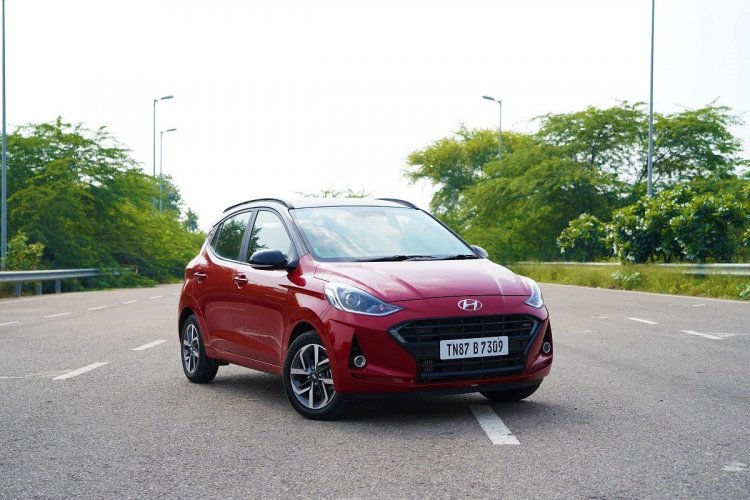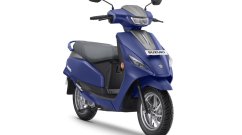As governing authorities are tightening up the emission regulations, carmakers are finding new ways to develop more power with smaller engines that emit fewer harmful gases. One of the largely accepted ways to do so is downsizing and turbocharging the internal combustion engines. While this practice has proved to be the right one, a lot of mass-market manufacturers have decided to stay away from it. But not Hyundai. The South-Korean carmaker is plonking a turbocharged GDI motor in almost all of its offerings. The list includes the Aura, Venue, Verna, and Creta. However, the brand has now fitted its 1.0L 3-pot force-fed petrol motor in the Grand i10 Nios with a couple of cosmetic changes. We recently got a chance to spend some time with it, and here’s how it feels like.
Hyundai Grand i10 Nios Turbo – Exterior
The Grand i10 Nios Turbo is based on the Sportz trim of the Nios, rather than being presented on the top-spec Asta variant. But, it for sure looks sportier in comparison to the regular Nios since Hyundai has tweaked it a bit. While it continues with the same lines, recesses, and haunches for the bonnet and the front bumper, the cascading grille gets piano-black finish with a ‘Turbo’ badge, and it is the only change that Hyundai has made on the front facet.
On the sides, the silhouette remains unchanged, but it now gets a dual-tone paint job with blackened out roof and pillars. Unlike the top-spec Asta trim which gets the chrome finish for the door handles, Grand i10 Nios Turbo gets body-coloured ones. But what it does get from Asta trim are the 15-inch dual-tone diamond-cut alloy wheels, which are not available on the Sportz variant. Also, it continues to get the black roof rails, which are hard to spot on the black-painted roof.
Moving to the rear, the only change that the Turbo variant boasts of in comparison to the other variants, it is the ‘Turbo’ badge on the boot lid. While there’s no other change to talk of, we think Hyundai could have tweaked the rear bumper, as is the case with the Turbo variant of bigger Verna. Nevertheless, the dual-tone paint scheme, a few Turbo badges, and absence of any chrome embellishment on the outside are the key giveaways that it is the sportier trim in the Grand i10 Nios’s line-up.
Hyundai Grand i10 Nios Turbo – Interior
The Grand i10 Nios offers a spacious cabin with a well laid-out dashboard. It seems like everything remains the same here except for the black-beige theme. With the Turbo variant, Hyundai has finished the cabin in an all-black colour scheme with red inserts at places. The seats on the Grand i10 Nios Turbo are also upholstered in black fabric and get red pipings. A similar suite is followed for the leather-wrapped steering wheel where the stitching is done with red thread.
Since the Turbo variant is based on the Sportz trim of the Grand i10 Nios, it gets a slew of features. But in comparison to the Asta trim, it misses out on a few. It has a wireless phone charging pad, 8.0-inch touchscreen infotainment unit with Android Auto and Apple CarPlay, automatic climate control, tilt-adjustable steering wheel, rear AC vents and more. However, it fails to get the push-button start-stop system, request sensors on the front door handles, cooled glovebox, rear washer and wiper, and adjustable headrests for the rear bench.
Overall, it is a decently loaded cabin with adequate space in both rows. Talking of the ergonomics, finding your perfect driving position is not a tough job here. Also, the rear seat is reclined at an angle that does not feel upright. Moreover, the seat base is fixed in a way that it offers generous under-thigh support. However, Hyundai could’ve managed to fix a couple of more airbags in the cabin, since the Turbo variant is projected as a go-faster iteration of the Grand i10 Nios.
Hyundai Grand i10 Nios Turbo – Engine & Gearbox
In this aspect, the Grand i10 Nios Turbo boasts of a big change as it gets the same 1.0L 3-pot turbocharged petrol engine as the Aura. This motor also does duties on the Verna and the Venue, but in a higher state of tune. However, here it belts out a peak power output of 100 PS and max torque of 172 Nm. It comes mated to a 5-speed manual gearbox only, as Hyundai has kept it away from the fast 7-speed DSG and the convenient 6-speed iMT.
In comparison to the other engine options that are offered with the Grand i10 Nios, this motor packs in a higher amount of punch. We have always sung the praises of this powerplant when we experienced it on the Venue, Aura, and Verna, and the case is the very same here as well. It has a strong mid-range pull and offers great top-end performance. However, it feels out of power in the low-end RPM range due to the evident turbo-lag. Once the turbo spools up, which happens around 1,500 RPM mark, this engine feels rev-happy and full of performance.
Talking of the gearbox, it is a smooth unit with well-defined gates and long gear ratios. The throws, however, are short. As far as the clutch is concerned, it has a long travel but is fairly light to operate. Nevertheless, with this engine and gearbox combination, one doesn’t need to shift too frequently. The rev-happy character of the motor and more than adequate performance on offer aids the driver with enough punch in reserve. Also, cruising at triple digits is a child’s play for this engine.
However, the only gripe we could come across with this motor was the NVH levels. It is evident at showing its 3-cylinder characteristics of unbalanced forces at the crankshaft that result in noticeable vibrations at idle. They can be felt at the steering wheel and the pedals. If the door is left open, one can see it vibrating as well. But it is a case with every 3-pot setup. On the positive side, however, the 3-cylinder engines are torquey and frugal, and this motor returns an ARAI-claimed mileage figure of 20.3 kmpl. To put the picture into perspective, the 1.2L 4-cylinder Kappa motor returns 20.7 kmpl, while churning out only 83 PS of peak power against 113 Nm of max torque.
Hyundai Grand i10 Nios Turbo – Ride & Handling
The Grand i10 Nios is a softly sprung car, and therefore it offers a plush, comfortable ride with its capability to soak all sorts of bumps, potholes, and undulations. On the Turbo variant, things remain unchanged too. It uses the same springs and dampers as the other trims of the Grand i10 Nios. The overall driving manners of the Grand i10 Nios are great, and it surely is a fun-to-drive car. But the added grunt of the turbocharged motor leaves you wanting for more. Also, this being a sportier iteration of the Grand i10 Nios, Hyundai had the chance to fit in a set of firm springs.
While the tighter suspension setup would’ve helped the Grand i10 Nios Turbo with better driving dynamics, it would’ve reduced the overall ride comfort and the body-roll. The latter is highly preferred by the buyers of this segment. For those few who have the urge to pull harder, the aftermarket route is filled with options.
Moving over to the steering wheel, it is light at city speeds and makes it easy to manoeuvre the Grand i10 Nios in tight parking spaces and chaotic city roads. With the rise in speeds, the steering wheel weighs up well too. However, there’s still some room for improvement, since it isn’t the most direct one we've come across.
Talking of the brakes, the Grand i10 Nios stops well in time, and the pedal offers adequate feedback. The brakes are precise and progressive. However, at times, the ABS feels intrusive. We felt that the reason behind this phenomenon is the Apollo Alnac 4G tyres, which are mileage-centric. Replacing them with a set of soft-compound rubber would surely help the brakes perform better. What we liked though is the fact that Grand i10 Nios Turbo stops without any drama, whatsoever.
Hyundai Grand i10 Nios Turbo – Verdict
Also Read - Hyundai Venue iMT - First Drive Review
The Hyundai Grand i10 Nios Turbo costs INR 7.70 lakh* for the single-tone avatar and INR 7.75 lakh* for the dual-tone paint-job. With this price tag, it comes up as a great bargain for those planning to get home a small, good-looking, and peppy hatchback. While this isn’t the most involving one to drive with the soft suspension setup, it surely has the right amount of ride comfort to serve as a daily driver. Moreover, the only car it competes with is the Volkswagen Polo TSI, which is priced at a premium of around INR 38,000. While the Polo offers better dynamics and is more involving to drive, Hyundai has a better after-sales & service network. Thus, it for sure seems like Hyundai has a winner in its hand in the small hot-hatch segment with the reliable, affordable, fast, and comfortable offering – Grand i10 Nios Turbo. But, if you need a driver’s car, we suggest, look elsewhere.
*Ex-showroom







































